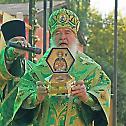Relics of St. Laurence of Kaluga discovered in museum, transferred to monastery
As the Church celebrated the memory of St. Laurence the Fool for Christ of Kaluga yesterday, a portion of his holy relics was festively transferred to the monastery named in his honor in Kaluga.
St. Laurence was a great ascetic of the Kaluga lands who is credited with the defeat of the Crimean Tatars in Kaluga in May 1512.
The relics of the 16th-century saint, and those of several others were discovered in storerooms in the Moscow Central Museum of the Armed Forces earlier this month, reports the site of the Metropolitanate of Kaluga.
The relics were discovered during a search in connection with the 700th anniversary of the memory of St. Michael of Tver, but the Lord deigned to reveal the relics of several saints beloved in the Orthodox world. According to a statement from the Tver Metropolitanate, large fragments of the relics of St. Michael and St. Laurence were found in a bag together. They were in fairly good condition, with tags indicating to whom they belong.
Through the efforts of Metropolitan Clement of Kaluga and Borosvk, the relics of Kaluga’s Heavenly patron were given to the Kaluga Church, where it was then decided to transfer them to the St. Laurence Monastery.
“On the day of the feast in honor of the holy righteous Laurence, August 23, a portion of the holy relics were transferred to Kaluga for the veneration of the faithful, to the monastery where the body of St. Laurence was at once buried,” the metropolitanate press service said.
Met. Clement festively greeted the relics of St. Laurence at the monastery yesterday morning, after which he celebrated the Divine Liturgy along with Bishop Nikita of Kozel and Lyudinovo, Bishop Seraphim of Tarusa, and a number of local abbots and clergy. Met. Clement blessed all the faithful with the relics and shared the story of how they were discovered in the museum.
Kaluga Province Governor A. D. Artamonov offered some words on the importance of St. Laurence and the finding of his relics: “Laurence was a revered saint in Russia. He defended the limits of the Russian land and Orthodox faith. This portion [of his relics—O.C.] will strengthen faith in our people. And we acknowledge and thank those who brought it to Kaluga.”
The festive Liturgy ended with a procession to the holy spring, where a moleben for the blessing of waters was served.
***
The site of the Orthodox Church in America provides the life of St. Laurence:
Blessed Laurence, Fool-for-Christ and Kaluga Wonderworker, lived at the beginning of the sixteenth century at the distance of half a verst from old Kaluga near a forest church in honor of the Nativity of Christ, set upon a high hill.
There was a long underground entrance from his dwelling to the church, where he attended services. He lived also at the home of the Kaluga prince Simeon Ioannovich. It is conjectured that Blessed Laurence was descended from the noble Khitrov lineage, since his name initiates their lineage memorial at the Peremyshl’sk Liotykov monastery, in the Kaluga diocese. Blessed Laurence went barefoot both winter and summer, in a shirt and sheepskin coat. By his struggles he so raised himself up that while still alive he was glorified by gifts of grace.
When the Crimean Tatars fell upon Kaluga in May 1512, Blessed Laurence, then in the home of the prince, suddenly shouted out in a loud voice: “Give me my sharp axe, for the curs fall upon Prince Simeon and it is necessary to defend him!” Saying this, he seized the axe and left. Suddenly having come on board ship next to the prince, Righteous Laurence inspired and encouraged the soldiers, and in that very hour they defeated the enemy.
He is depicted in icons with an axe in his right hand, set upon a long handle. It is certain that Prince Simeon (+ 1518), owing him his safety, built a monastery in his memory on the site of the saint’s ascetic labors.
Blessed Laurence died on August 10, 1515, on his name's day. The memory of the saint is honored also on July 8.
Blessed Laurence was glorified, it seems, in the second half of the sixteenth century. Thus, Tsar Ivan the Terrible in a deed of donation to the monastery (1565) wrote: “Monastery of the Nativity of Christ, where lies Laurence, the Fool-for-Christ.” In the Life, the first posthumous miracle is recorded under the year 1621: the healing of the paralyzed boyar Kologrivov, who became well after a moleben to the saint.
Source: Orthochristian.com










